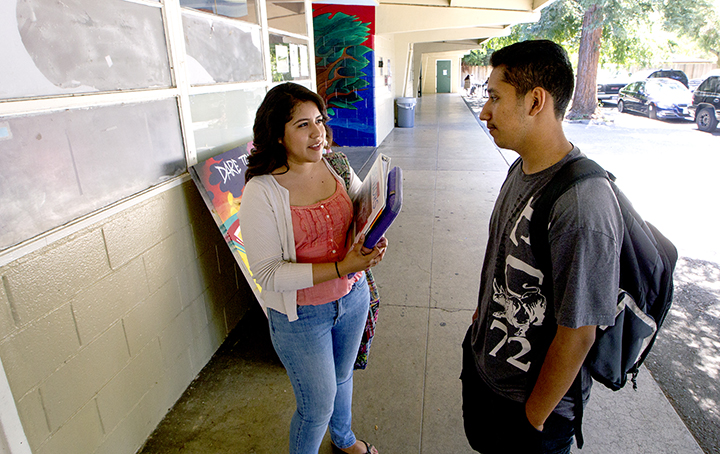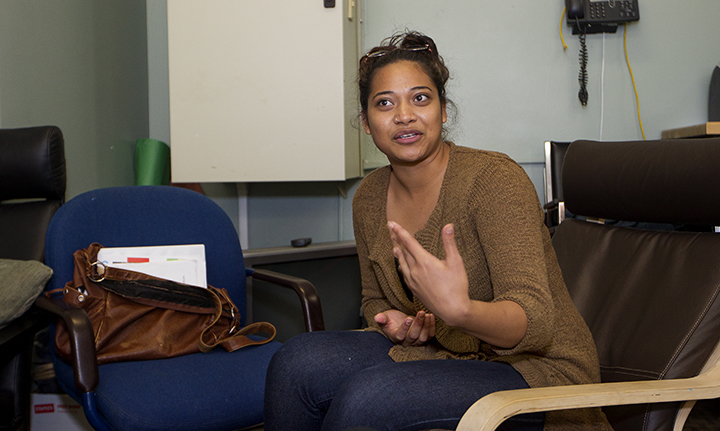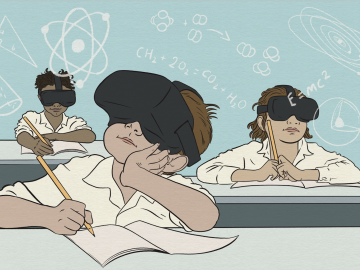


Para leer la versión de esta historia en español, por favor pulse aquí.

Before Blanca Diaz entered high school, she didn't think a cap and gown were in her future. After all, her two older siblings never made it to graduation, why would she?
"My mindset was that I would drop out, too," she said. "I was afraid I couldn’t do it."
But on Thursday, Diaz will accept her diploma from East Palo Alto Academy, where she entered as a terrified ninth grader and now leaves as senior class president, founder of the school's computer coding club and college-bound.
She credits much of her success to her teachers, who became her role models, and her classmates, who became her family.
"This community, this school, gave me confidence," she says. "High school ended up not being scary, it was supportive."
Diaz is one of 56 seniors graduating this year from EPAA, a charter school affiliated with the Stanford Graduate School of Education. The commencement ceremony takes place June 5 in Memorial Auditorium on the Stanford campus, where Diaz will return in a few months — as a Stanford freshman, class of 2018.
"The teachers believed in me even if I didn't," Diaz says. "They showed me college was a possibility."
A version of Diaz’s story can be heard from each of her classmates, many of whom also didn't think they had the tenacity to make it through —because of challenges at home, in the classroom, or both.
Unlike many of their neighbors in Silicon Valley, where the average home price is upwards of $1 million and the median income is around $90,000, the students at EPAA come from families with much more limited means.
Most of the students live in East Palo Alto and the east side of Menlo Park which have not seen the riches of the tech boom. They describe living in cramped apartments with sisters, brothers, parents and grandparents. They talk about attending vigils for friends struck down on street corners. They recall relying on food stamps for groceries, shelters for bed. They act as translators for their parents. They act as caretakers for their siblings. They work to help their families with electric bills, car payments, clothes.
And, they go to school.
“I have learned how to prioritize,” said graduating senior Gurjeet Chahal, who has worked since he was 7 years old, first doing construction, then at the Goodwill and more recently for a social justice nonprofit. “But at least at EPAA, you’re not alone in this. That doesn't mean, though, that teachers bend on assignments. But activities are at different times, your advisor helps you out. At another school, you would just be put into remedial classes and forgotten about.”
About 265 students attend EPAA. The demographic breakdown is about 83 percent Hispanic, 8 percent black, 7 percent Pacific Islander and less than two percent White, Indian or Asian.
Nearly all students qualify for free or reduced lunch, and about 86 percent of students don't speak English as their primary language at home. Almost two-thirds of students have parents who did not graduate high school.
All of these statistics typically add up to low high school completion rates. But at EPAA, the number of seniors earning diplomas has been consistently more than 90 percent — this year it's about 98 percent. College matriculation is also high. This year, 51 of the 56 graduating seniors plan to attend a two- or four-year college.
“In terms of graduation rates and getting into college, EPAA is off the charts,” says Deborah Stipek, the I. James Quillen Dean of the Stanford GSE. “I believe that the individual attention they receive from their advisor and other teachers and the supports for social development and mental health are central ingredients in the success of the school. These supports are unusual in schools that serve students like ours. ”
EPAA opened its doors in 2001, after community leaders asked Stanford to develop a charter school that would serve East Palo Alto, which, for 25 years, had been without a high school. The district was busing students to other schools, and less than 40 percent of them were graduating.
The academy is now operated with a charter1 from the Sequoia Union High School District and will move from its current location in Menlo Park to grounds in East Palo Alto later this month. The new facility has more space to accommodate expected growth in the school, which continues a strong relationship with Stanford.
Stanford faculty support curriculum development, and instructional design, and have partnerships that allow students and teachers to attend workshops on the university campus, and bring mentors for EPAA students and teachers to the academy. About 15 EPAA students each year learn physics in Stanford labs.
“The research on my community I did with a Stanford professor (Al Camarillo) was what ended up getting me really excited about school,” Diaz said about a project that had her digging through newspaper archives and other historical documents to learn about how East Palo Alto came to be. “I started becoming really proud of my community.”

Through project-based, student-centered learning, students at EPAA get a very personalized school environment. An advisory program connects them with teachers who meet with them daily.
“Irene Castillon is my inspiration,” says graduating senior Lucia Gonzalez, who immigrated to the U.S. when she was four, not knowing a word of English. “We had an instant connection. She comes from a similar background. We clicked.” Castillon is Gonzalez’s advisor, an EPAA teacher and a graduate of the Stanford Teacher Education Program (STEP).
Teachers lend support where parents sometimes can't either because of work commitments or language barriers, says Edgar Arroyo, who wants to return to EPAA after college to teach.
“Teachers here have given me so much, and they've shown me how important getting an education is,” he says. “I want to give that back to other kids who have grown up like me.”
In interviews, students described EPAA using words like family, home, inspirational, phenomenal, caring, compassionate and loving.
Angie Petelo transferred to EPAA her senior year, worried she wouldn’t complete high school had she stayed in her old school, where she “fell into the wrong crowd.”
“Here, we relate to each other, we don’t look down on each other,” she said. “Support is literally all around you.”
That support, the students say, is what helped get them to Thursday, and beyond.
They’ll be enrolling at such colleges as University of the Pacific, Oregon State, University of San Francisco, Foothill College, Cabrillo College and various University of California and California State University campuses.
Petelo is headed to CSU Humboldt, while Chahal will start at UC San Diego. Arroyo will drive north to CSU Sonoma and Gonzalez will go south for Loyola Marymount University.
And Diaz is excited about her next four years at Stanford. Neither terrified, nor feeling destined to drop out, she has a decidedly different mindset from four years ago.

For a slideshow and video of East Palo Alto Academy's 2014 commencement, please visit https://ed.stanford.edu/news/photo-slideshow-epaa-graduation-2014.
1EDITOR'S NOTE: The Sequoia Union High School District Board of Trustees voted June 25 on a new charter agreement for EPAA. Learn more here.
Subscribe to our monthly newsletter.
Stanford Graduate School of Education
482 Galvez Mall
Stanford, CA 94305-3096
Tel: (650) 723-2109
© Stanford University, Stanford, California 94305.



